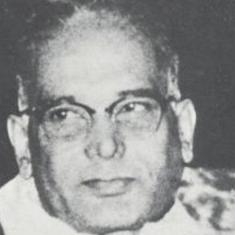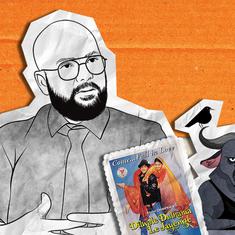This is not the first time the National Gallery has combined its paintings with other art forms – you can see some excellent examples on their Inspired by the Collection website. What is new, though, is the admission of sound directly into the hallowed – and normally hushed – presence of the paintings themselves.
In a culture dominated by the looked-at (and especially the looked-at-on-a-tiny-screen) this represents something of a coup for the often neglected art of the heard. But if you think the idea of combining sight and sound in art is a novel one, think again: multimedia art forms hark back as far as ancient Greece.
Ancient Greek multimedia
While the fusing of sound and image might seem like a product of our multimedia age, it actually has a long history. In 1598, composer Jacopo Peri and librettist Ottavio Rinuccini invented a completely new art form, inspired by a fusion of the arts in ancient Greek theatre. They combined existing musical and theatrical practice to create Dafne; a performance widely recognised as the first true opera.
Russian composer Modest Mussorgsky’s Pictures at an Exhibition was famously inspired by a retrospective of paintings by his friend Viktor Hartman, exhibited shortly after his untimely death in 1873. Meanwhile, Mussorgsky’s contemporary, Wagner, was obsessed with unifying all the art forms in his operas. Wagner was inspired – like Peri before him – by the ancient Greek multimedia tragedies of Aeschylus. Next, Scriabin went even further, including a part in his orchestral work Prometheus (1910) for a “colour organ”. Rather than producing sound, Scriabin’s organ projected pools of coloured light onto a screen.
A 2010 performance of Prometheus.
The Lumière brothers almost unthinkingly invented film music when their first public cinema screening in 1895 was accompanied by a guitarist. By the mid 1920s, the possibility of synchronising sound recording with moving images was transforming cinema music from improvised accompaniment to an integral part of the craft of film.
Today, the continuing development of technology has transformed this undreamed of possibility of inter-art fusion into the norm. Most of our music is experienced with visuals thrown in, from film and TV music, to pop and rock videos, to computer games. But in this fusion of art forms, is it inevitable that sound, like the Lumière’s guitarist, will be reduced to mere background?
Nothing to see
While technology enabled artists to fuse image and music, it also made possible for the first time an art of pure sound, in which there is deliberately nothing to see – not even musicians. Pierre Schaeffer, an engineer at French Radio during the Nazi occupation, saw the potential of sound recording to create a wholly new art form.
Schaeffer pioneered a form where recorded sounds could be heard, not just as effects in radio plays, but as artistic objects in their own right. He coined the term “musique concrète”, and created its first example – Etude aux chemins de fer – in 1948.
Etude aux chemins de fer.
Rather than embracing an inter-arts approach, musique concrète went out its way to distance itself from the visual, and even from the real world altogether. Schaeffer used sound recording and loudspeakers, not just to create an art form where there is nothing to see, but to dispense with the meaning of sounds altogether. In listening to sounds without thinking about what has made them, he hoped to reveal sonic details that sight and meaning usually drown out. What’s that we hear; is it a bird? Is it a plane? No, it’s … a sound. Pure and simple. Beautiful, subtle, scintillating sound, intended simply for the joy of sound itself. Almost like, well – music.
Opportunity and challenge
The National Gallery has carefully chosen forms of sound making that have very different natural habitats, and different relationships with the visual; concert hall, cinema, club, gallery, nature. There are contributions from a range of artists, from Oscar-winning soundtrack composer Gabriel Yared to DJ and producer Jamie xx. Soundscapes represents a kind of inventory of the many ways in which we encounter artistic sound in the digital age.
This is an exhibition which promises to widen the audience for both painting and sound art, and to give us a new experience of both. It may even encourage musicians to look more, and art lovers to do more listening. But perhaps it also speaks to a growing reluctance, in today’s everything everywhere culture, to do either. It could be that we gradually losing the ability – or perhaps just the patience – to listen to music for its own sake, without needing something to keep our eyes busy too. Or, for that matter, to look at a painting. That’s all. Just look.
This article was originally published on The Conversation.










